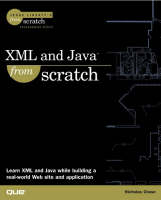
XML and Java From Scratch
Que Corporation,U.S. (Verlag)
978-0-7897-2476-2 (ISBN)
- Titel ist leider vergriffen;
keine Neuauflage - Artikel merken
With the help of XML and Java from scratch, you will build a Web site and application for ChaseWeb Furniture-a fictitious catalog furniture company. All of the information on products, prices, vendors, and so on, is rendered in XML. You'll learn how to display products on the company Web site, take orders, produce a paper catalog, and communicate with the external databases of vendors using XML. The from scratch format is designed to teach novice programmers the hows and whys of programming in the context of creating a functioning application.
Nicholas Chase has been involved in Web site development for companies such as Lucent Technologies, Sun Microsystems, and Oracle Corporation. He got his first email account in 1989, and before immersing himself in the Web, he was a physicist, a high school teacher, a low-level radioactive-waste facility manager, an online science fiction magazine editor, a multimedia engineer, and an Oracle instructor. He is currently the chief technology officer of Site Dynamics Interactive Communications in Clearwater, Florida. He is also the author of Active Server Pages 3.0 from scratch. He enjoys watching sunsets with his lovely wife Sarah and their teenage son Sean.
Introduction.
1. Vendor Pages: Styling XML with Cascading Style Sheets.
Walking Before We Run: HTML and XHTML. Controlling Presentation: Cascading Style Sheets. Delving Deeper into CSS2.
Color. Background. Border. Positioning Elements. Text Properties. List Item Properties. Tables. Display and Inheritance. Inheritance.
Converting Our Content to XML.
Our XML Structure.
Next Steps.
2. Product Pages: Transforming XML in the Browser Using XSL.
The Two Faces of XSL: XSL Transformations and XSL Formatting Objects. Getting Ready.
Installing MSXML3. Testing the Installation. What We're Shooting For. Our XML Source File.
Trees: The Basic Structure of XML.
Applying the Structure to XSL.
Well-Formedness. Building the Style Sheet.
Associating the Style Sheet with the XML Document.
Templates. Getting Specific-Using XPath. Looping and Sorting.
Sorting.
Adding Elements and Attributes. Conditionals.
Cleaning Up.
Next Steps.
3. Defining the Data Structure: Document Type Definitions, XML Schema, _and Parsers.
Introducing Java. Installing the Java 2 Software Development Kit.
Locating the Java 2 SDK. Installation.
Installing the Xerces-J Parser.
Installing Xerces-J. Setting the CLASSPATH. Testing the Installation.
Well-Formed Versus Valid Documents.
To DTD or Not to DTD.
Document Type Definitions.
Internal DTD Subsets. Attribute Definitions. Mixed Content. DTD Syntax Review. The First Limitation: Datatypes.
External DTDs.
Adding the Rest of Our Vendors.
Referential Integrity.
The Second Limitation: Keys. The Third Limitation: Same Name, Different Element.
XML Schema.
Datatypes. Features Still to Come.
Next Steps.
4. Getting Serious: XSL Processors and Server-Side Processing.
XSL Processors. Xalan.
Installing Xalan. Testing the Installation.
Converting a File from the Command Line.
Input and Output Files. Processing the Document.
Advanced XSLT: Includes and Imports.
Includes. Imports.
Java Basics.
Diving Right In: Hello World! Writing HelloWorld. Compiling HelloWorld. Executing HelloWorld. What It All Means. Inheritance. Looking at HelloWorld.
Reading a File from a Java Application.
Declaring Variables. Displaying the Contents of a File. Exceptions.
Transforming an XML File from Within a Java Program.
Creating the Style Sheet.
Advanced XSLT: Parameters. Our First DOM: Stepping Through Our XML. Automating Further: Adding Next and Previous Links. Adding a Web Server to the Mix. Installing and Configuring Tomcat.
Completing the Installation. Testing the Installation.
The First Servlet. Extracting Request Information.
Getting It Together.
Next Steps.
5. Taking Orders: Manipulating Data with JDOM.
What Is JDOM? Installing JDOM.
Installing JDOM. Setting the CLASSPATH. Running the Samples.
Developing an Algorithm.
The Overall Algorithm.
Creating the Shopping Cart-AddToOrder.java.
Adding post to the Servlet.
Manipulating an XSL Style Sheet. Next Steps.
6. Adjusting Inventory: Using Namespaces and More About DOM.
Manipulating In-Memory Documents.
Creating the New Document. Creating DOM Objects.
The Structure of a DOM Document.
Recursion.
Adding Nodes to a Document. Serializing the Document.
Adding Data. Adding the Products to the Document. Cleaning Up.
Adding Namespaces. Retrieving Namespace Information. Creating the Review Page. Working with the Results of the Transformation. Working with Our Temporary Document. The Final Style Sheet. Collecting Payment Information. Accepting Payment Information. Next Steps.
7. Product Search: XQL.
Downloading the GMD-IPSI XQL Engine. Creating the Index File. Creating the Search Page. The Search Results Page. Performing the Search.
Enhancing the Search.
Next Steps.
8. Updating Inventory: SQL Databases and SAX.
Connecting to the Database: JDBC, ODBC, and SQL. Creating the Inventory Database.
Creating the ODBC Connection. How We Connect to a Database /li>.
Creating the Initial Inventory.
Inserting Data.
Introduction to SAX: Adjusting Inventory. Using SAX to Parse the File. Updating the Database. Retrieving Information from the Database: Backorders. Completing the Circle. Next Steps.
9. Other Applications for XML (SOAP).
Browser Detection.
Request Headers. Resource Bundles.
Media. Mobile Phones.
Downloading the Simulator. The WML Page.
Adapting a Servlet for Wireless Devices. The Simple Object Access Protocol (SOAP).
How SOAP Messages Are Passed. HTTP Requests and Responses. Taking It a Step Further.
Formatting Objects.
Downloading, Installing, and Testing FOP. The Structure of a Formatting Objects File.
Where We Go from Here. Getting More Information.
More Information on This Book.
The Last Word.
Index.
| Erscheint lt. Verlag | 21.3.2001 |
|---|---|
| Sprache | englisch |
| Maße | 188 x 229 mm |
| Gewicht | 828 g |
| Themenwelt | Informatik ► Programmiersprachen / -werkzeuge ► Java |
| Mathematik / Informatik ► Informatik ► Web / Internet | |
| ISBN-10 | 0-7897-2476-6 / 0789724766 |
| ISBN-13 | 978-0-7897-2476-2 / 9780789724762 |
| Zustand | Neuware |
| Haben Sie eine Frage zum Produkt? |
aus dem Bereich


